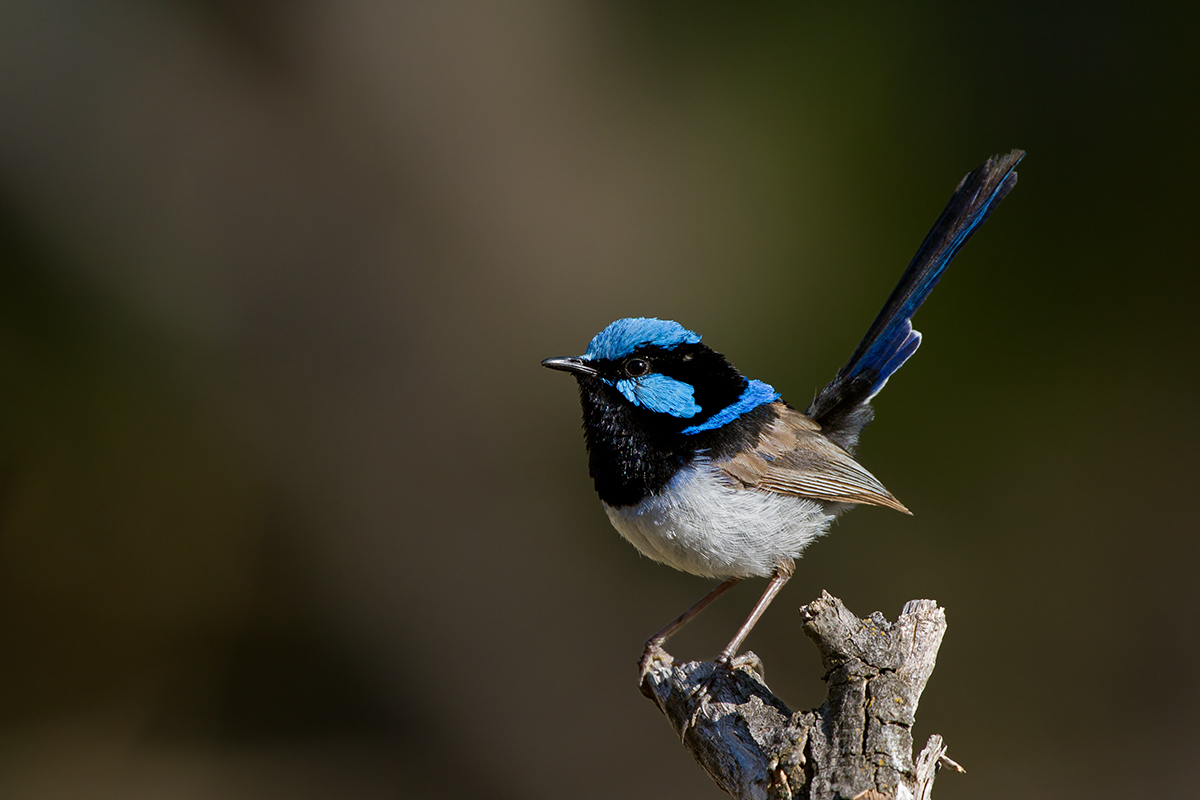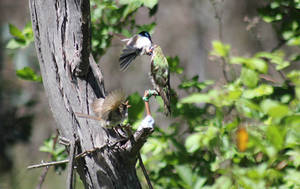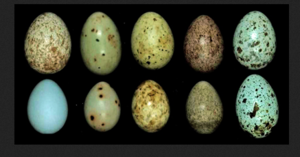The ability to learn from those around you - social learning - is a key feature of animal societies as well as our own. Far from being restricted to large-brained primates like us, new research shows that  superb fairy wrens also learn from observing group members, obtaining information on how to react appropriately to threat [1].
superb fairy wrens also learn from observing group members, obtaining information on how to react appropriately to threat [1].
To survive and reproduce successfully, animals must learn to distinguish between harmless co-habitants of their territory, and species that may be harmful, either predators, or brood parasites. Brood parasites, the con-artists of the animal world, lay their eggs in the nests of unsuspecting hosts, who then raise the chick as their own, the most well known example being the cuckoo [2]. If this goes undetected it can be severely detrimental to the unwitting hosts: their chicks suffer from a reduction in care as they must feed an extra, unrelated mouth. In some cases, the parasitic chick may even eradicate its competition by booting its adoptive siblings out of the nest, killing them [3].
When it comes to brood parasitism, prevention is the best cure. Cuckoo species have developed sophisticated egg mimicry to fool hosts and evade detection [4]. The risk of not detecting an extra egg, or expelling your own egg by mistake, is high. For species regularly targeted by brood parasites, it therefore pays to learn to recognise them in order to deflect parasitism attempts before they occur.
Will Feeney and Naomi Langmore at the Australian National University have shown that one cuckoo target species, the superb fairy wren, does just that. Wrens that had never seen cuckoos before did not react to their presence, but after just one incidence of seeing group-members reacting violently to a cuckoo; they too displayed an aggressive reaction when they were presented with a cuckoo again.
Crucial to their experimental design was access to wrens that had never shared their environment with cuckoos. Wrens that had hatched during years when cuckoo parasitism was rare had never been exposed to cuckoos before - these were termed "cuckoo-naive" individuals. Feeney and Langmore's field work in south-eastern Australia focused on naive individuals that existed within groups that also contained individuals with experience of cuckoos. This allowed them to determine whether naive wrens learned from observing more experienced group members.
 When naive wrens were presented with a freeze dried specimen of a bronze-cuckoo, and then a familiar but harmless honeyeater, they did not react to either. Whole groups were then presented with the cuckoo, and then separately with the honeyeater. As expected, experienced individuals reacted with alarm calls and a typical behaviour called "mobbing", which Feeney describes as looking like "ants on a carcass - the wrens whine and peck at [the cuckoo's] eyes and the back of their head".
When naive wrens were presented with a freeze dried specimen of a bronze-cuckoo, and then a familiar but harmless honeyeater, they did not react to either. Whole groups were then presented with the cuckoo, and then separately with the honeyeater. As expected, experienced individuals reacted with alarm calls and a typical behaviour called "mobbing", which Feeney describes as looking like "ants on a carcass - the wrens whine and peck at [the cuckoo's] eyes and the back of their head".
The wrens make two alarm calls to alert group-mates to danger. The first is a general mobbing call which acts as an alarm. "They're the calls they'll make to people, or other animals, near their nest," Feeney explains. The wrens, however, have a special alarm call which alerts group members to one specific threat - cuckoos. "Whining calls have only been seen (both in experiments and in the wild) in response to cuckoos. And, once these calls are made, the rest of the group shows up pretty quickly to join in mobbing."
Naive wrens were totally unresponsive to cuckoo models before they witnessed mobbing by other group members. This all changed, however, after one crucial learning experience. When they were presented with a model cuckoo after they had observed their group's aggressive reaction, they made significantly more alarm calls of both types, and spent more time mobbing the model cuckoo.
 Experimental presentations took place during late nest-building when the need to successfully repel brood parasites is highest, and when cuckoos are most likely to monitor host nests. The quick learning demonstrated by wrens shows the evolutionary importance in overcoming the threat of brood parasitism. There was no change in the response to honeyeaters before and after the group trials, confirming that wrens are indeed learning to identify actual threats, retain this information, and act appropriately in future occurrences.
Experimental presentations took place during late nest-building when the need to successfully repel brood parasites is highest, and when cuckoos are most likely to monitor host nests. The quick learning demonstrated by wrens shows the evolutionary importance in overcoming the threat of brood parasitism. There was no change in the response to honeyeaters before and after the group trials, confirming that wrens are indeed learning to identify actual threats, retain this information, and act appropriately in future occurrences.
But learning to recognise and repel cuckoo parasites may be just one more step in an evolutionary arms-race between parasites and hosts, in which both try to maximise their reproductive success by outwitting the other. Could enhanced recognition drive the evolution of further sneaky tactics by brood parasites? If so, what is the next stage in this race?
"While no one has really looked at it, bronze-cuckoos have evolved colouration that makes them as [hard to see] as possible," says Feeney. "And host recognition of common cuckoos has driven the evolution of differences in colour within the same species (some common cuckoos are grey while others are red) to help decrease recognition by their hosts." With work in the offing to discover what other tactics hosts and parasites employ, this battle to overcome the strategies of the other is an ongoing story of evolution in action.
References
- Previous Caffeine: the world's addiction
- Next Dog doctors










Comments
Add a comment